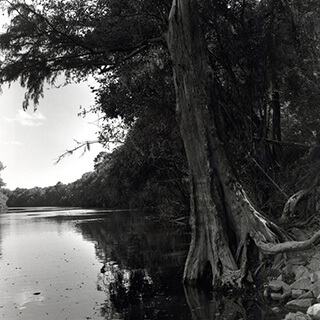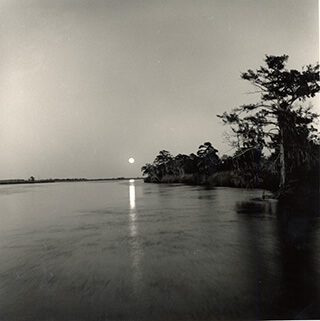Overview
Matthew D. Owen reviews Christopher J. Manganiello’s Southern Water, Southern Power: How the Politics of Cheap Energy and Water Scarcity Shaped a Region (Chapel Hill: University of North Carolina Press, 2015).
Review

Christopher J. Manganiello opens Southern Water, Southern Power: How the Politics of Cheap Energy and Water Scarcity Shaped a Region with a discussion of the drought that hit the southeastern United States in 2008. As water levels dropped, the city of Atlanta found itself in a particularly precarious position. Wholly dependent on supplies beyond its control, the city faced the possibility of being unable to meet the water needs of its residents. For Manganiello, policy director at the Georgia River Network and an environmental historian, the 2008 crisis raises an important question: How, in an area with an abundance of rainfall and dammed waterways, could water security remain a problem in the twenty-first century? Manganiello's search for answers winds through more than one hundred years of political and environmental history on the Savannah River and its tributaries as he analyzes the relationship between water, energy, and politics.
Manganiello frames the history of modernization in the Savannah River basin as a series of conflicts over water resource development. It is a history of "building new working, living, and leisure environments," (12) of the ways in which "decisions informed by energy needs and water insecurity influenced physical and political landscapes," (20) and, at its core, a history of "how private corporations, public institutions, and citizens challenged one another to manage natural resources equitably while stimulating and sustaining economic growth" (12). There is much in this book that will be familiar to scholars of southern history in the twentieth century1 See Bruce J. Schulman, From Cotton Belt to Sunbelt: Federal Policy, Economic Development, and the Transformation of the South, 1938–1980 (Durham: Duke University Press, 1994); and, more recently, Kari Frederickson, Cold War Dixie: Militarization and Modernization in the American South (Athens: University of Georgia Press, 2013).—the role of local boosters, corporations, and federal spending, the efforts to attract industry, the intermingling politics of race and class, and the urban-rural divide. Manganiello, however, much like Marc Reisner in his study of the American West, emphasizes water politics, encouraging readers to see the consequences of environmental decision-making in the Savannah and its tributaries.2 Marc Reisner, Cadillac Desert: The American West and Its Disappearing Water (New York: Penguin Books, 1986).

Manganiello organizes his analysis into three periods: New South (1890–1930), New Deal (1930–1944), and Sunbelt (post-1945). Although he acknowledges that the boundaries between them are hardly distinct, Manganiello uses these periods to explore the individuals and groups who controlled riverine development and the ways in which the pursuit of water security changed. This approach allows him to focus on private power companies and the hydroelectric dams they built in the early twentieth century; the federal government's foray into regional watershed development and energy production, including the creation of a "big dam consensus" during the New Deal; and the subsequent rise of that consensus, which the US Army Corps of Engineers and local boosters generally embraced, as well as its eventual fall in the post-World War II era. Periodizing history in this way facilitates Manganiello's emphasis on the twentieth-century shift from quantity to quality in water politics as the "big dam consensus" began to crumble under pressure from rural conservatives, who favored smaller farm-based projects, and a coalition of scientists and middle-class suburbanites, who pushed for the preservation of free-flowing streams. It also helps Manganiello demonstrate how recurring cycles of flooding and drought, abundance and scarcity, shape popular support for different water projects and policies. Throughout Southern Water, Southern Power, he explores the limits of different attempts to overcome water insecurity as the solutions preferred during one era either failed to solve the problems for which they were designed or presented new challenges that had to be addressed as the definition of security expanded beyond the management of floods and droughts to include the protection of recreational opportunities provided by free-flowing streams.
Manganiello makes a compelling argument that water resource development in the Savannah River basin is deeply intertwined with political, social, and economic history. He observes that conversations about recreation opportunities at new dams after World War II "among leisure-seekers, state planners, elected officials, and federal bureaucrats always included discussions about race, class, and gender," (103) quoting Strom Thurmond, then governor of South Carolina, who argued that the Army Corps of Engineers' projects would result in "beautiful parks, for whites and blacks, separate parks" (105). He also highlights the states' rights rhetoric of landowners who accused the Army Corps of Engineers of socialism in their effort to oppose the Corps' water projects. As Manganiello points out, accusations of socialism and appeals to states' rights were part and parcel of larger conflicts over federal involvement in the production of electricity, but also bespoke a disaffection with the direction of resource development among some rural conservatives who had experienced few benefits from the large dams that flooded their land while providing water, energy, and recreational opportunities to residents of cities and towns. This urban-rural divide was not limited to the construction of dams. While middle-class outdoor enthusiasts claimed the Chattooga's federal designation as a Wild and Scenic River in the 1970s as a victory, local residents, for whom rivers were "places 'to live rather than to visit,'" (184) found themselves dispossessed of an important resource because access to the river and surrounding land was curtailed.

By emphasizing connections between local water projects and larger political, social, and economic debates, Manganiello reminds readers that water resource development on the Savannah and its tributaries not only produced winners and losers, but also demonstrated the power of well-connected individuals, private capital, and federal agencies. In doing so, he successfully situates water politics within a larger historiography.3 Reisner, Cadillac Desert; Richard White, Organic Machine: The Remaking of the Columbia River (New York: Hill and Wang, 1995); and Donald J. Pisani, Water, Land, and Law in the West: The Limits of Public Policy, 1850–1920 (Lawrence: University Press of Kansas, 1996).
Manganiello challenges modernization narratives in southern history through his analysis of private electric companies. As he notes, the Tennessee Valley Authority (TVA) has long overshadowed these companies, and few scholars explore their role in resource development before the New Deal. In contrast, Manganiello demonstrates that companies like Duke Power and Georgia Power in the Catawba and Savannah River basins, respectively, built multiple dams during the early twentieth century to aid in generating hydroelectric and coal-fired power while serving as de facto chambers of commerce and attracting industry to urbanizing areas. The pattern of water resource development in this period reflected the goals of men like Preston S. Arkwright, Sr., president of Georgia Power, and James B. Duke, resulting in projects that brought cheap electricity to cities while bypassing, as Manganiello points out, the rural countryside.
Depicting the influence of private power companies during the New South era is Manganiello's most important contribution in Southern Water, Southern Power. He notes how scholars have emphasized the efforts of local governments, industrialists, and boosters, among others, to explain industrial and urban growth in the South prior to the New Deal but have rarely integrated discussions of water and energy into their histories. His analysis of Georgia Power on the Savannah and Duke Power on the Catawba claims a similarly active and extensive role for corporations and local boosters in the improvement of water resources prior to the 1930s, one that is obscured by the voluminous scholarship on TVA and the New Deal, which often paints the South as a largely passive vessel for federal development programs.4Sarah T. Phillips, This Land, This Nation: Conservation, Rural America, and the New Deal (Cambridge: Cambridge University Press, 2007); and Schulman, From Cotton Belt to Sunbelt.

As Manganiello demonstrates, politically and economically powerful men pursued a vision of a modern, capitalist South predicated on developing rivers to produce cheap energy and promote economic growth well before TVA's arrival. The influence of Preston Arkwright, James Duke, and the power companies they built extends well into the postwar era.
While Manganiello's analysis of private electric companies is well executed and much needed, his investigation of federal agencies and their role is incomplete. For example, he uncritically presents the claims of TVA's opponents—that the agency's emphasis on regional planning threatened racial norms and that establishing additional TVAs would allow the federal government to meddle in southern politics and society—to explain why similar agencies were not created on additional river systems. Other scholars, however, have demonstrated that TVA had largely abandoned intensive regional and community planning by the late 1930s,5 Erwin C. Hargrove, Prisoners of Myth: The Leadership of the Tennessee Valley Authority, 1933–1990 (Princeton, New Jersey: Princeton University Press, 1994). that it was no purveyor of progressive racial politics,6Nancy L. Grant, TVA and Black Americans: Planning for the Status Quo (Philadelphia: Temple University Press, 1990). and that it chose to administer its agricultural programs through existing institutions that favored local elites.7 Philip Selznick, TVA and the Grass Roots: A Study in the Sociology of Formal Organization (New York: Harper & Row, Publishers, 1966).
To be sure, the major concern of Southern Water, Southern Power is neither TVA nor the Tennessee Valley, but rather water politics in the Savannah River basin, a context in which this anti-TVA rhetoric voiced opposition to the creation of more quasi-federal regional agencies. Nevertheless, by allowing the straw man set up by the Authority's opponents to stand, Manganiello too easily dismisses TVA's influence on resource development outside its service area. He similarly downplays the importance of other federal agencies, observing that the Army Corps of Engineers relied on private power company executives and engineers when drafting plans for rivers like the Savannah. Uncovering the ways in which private utilities influenced the origins and evolution of riverine development is both necessary and illuminating, but given the federal government's active participation in Manganiello's "big dam consensus," his efforts to minimize the importance of agencies like TVA and the Corps seem forced.

Manganiello does make a convincing argument for paying attention to local and regional actors in water resource development, but he could do more to investigate the changing relationships between federal agencies and power companies before and after the New Deal. Doing so would provide another layer to his analysis of the rise and fall of the "big dam consensus" and could help explain why federal agencies and pro-dam advocates embraced multipurpose projects that combined navigation, flood control, and electricity generation beginning in the 1930s. This was an important shift politically, economically, and environmentally that distinguished the earlier hydroelectric-centric projects of private utilities from dams built by TVA and the Corps, a shift that Manganiello acknowledges, but largely ignores.
Manganiello also could do more to delimit the regional scope of his conclusions in Southern Water, Southern Power. He refers to the South and the southeastern United States throughout, but provides no explicit definition of either, coming closest when observing that reservoirs "dot the landscape from Mississippi east to Georgia and north through the Carolinas" (10). His analysis is strongest when discussing riverine development in the piedmont of Georgia and the Carolinas and in particular the similarities between Duke Power's efforts on the Catawba River and Georgia Power's projects on the Savannah. As a study of this smaller geographic region, Southern Water, Southern Power is excellent. While Manganiello's premise that the Savannah can be used to "tell multiple river stories in a single Piedmont space" (12) seems reasonable, his faith in readers to divine the bounds of his study through his use of "South" and "Southeast" as descriptors is misplaced.
These issues aside, Manganiello has produced a thought-provoking history of energy and water politics in Southern Water, Southern Power. He draws attention to the oft-ignored role of private electric companies in water resource development. More importantly, his work challenges readers to consider whether ostensibly modernizing policies pursued to increase water security have in fact reduced it. 
About the Author
Matthew D. Owen is an environmental historian and senior research associate for the Tennessee Advisory Commission on Intergovernmental Relations. He holds a PhD in history from Vanderbilt University where his dissertation was titled, "For the Progress of Man: The TVA, Electric Power, and the Environment, 1939-1969."
Recommended Resources
Text
Frederickson, Kari. Cold War Dixie: Militarization and Modernization in the American South. Athens: University of Georgia Press, 2013.
Hart, T. Robert. "The Lowcountry Landscape: Politics, Preservation, and the Santee-Cooper Project." Environmental History 18, no. 1 (January 2013): 127–56.
Phillips, Sarah T. This Land, This Nation: Conservation, Rural America, and the New Deal. Cambridge: Cambridge University Press, 2007.
Reisner, Marc. Cadillac Desert: The American West and Its Disappearing Water. New York: Penguin Books, 1986.
Schulman, Bruce J. From Cotton Belt to Sunbelt: Federal Policy, Economic Development, and the Transformation of the South, 1938–1980. Oxford: Oxford University Press, 1991.
Web
American Rivers. http://www.americanrivers.org.
Georgia Department of Natural Resources, Environmental Protection Division. Georgia's State Water Plan. http://www.georgiawaterplanning.org.
Georgia River Network. http://www.garivers.org.
The National Drought Mitigation Center. United States Department of Agriculture. United States Drought Monitor. http://droughtmonitor.unl.edu/Home/RegionalDroughtMonitor.aspx?south.
Similar Publications
| 1. | See Bruce J. Schulman, From Cotton Belt to Sunbelt: Federal Policy, Economic Development, and the Transformation of the South, 1938–1980 (Durham: Duke University Press, 1994); and, more recently, Kari Frederickson, Cold War Dixie: Militarization and Modernization in the American South (Athens: University of Georgia Press, 2013). |
|---|---|
| 2. | Marc Reisner, Cadillac Desert: The American West and Its Disappearing Water (New York: Penguin Books, 1986). |
| 3. | Reisner, Cadillac Desert; Richard White, Organic Machine: The Remaking of the Columbia River (New York: Hill and Wang, 1995); and Donald J. Pisani, Water, Land, and Law in the West: The Limits of Public Policy, 1850–1920 (Lawrence: University Press of Kansas, 1996). |
| 4. | Sarah T. Phillips, This Land, This Nation: Conservation, Rural America, and the New Deal (Cambridge: Cambridge University Press, 2007); and Schulman, From Cotton Belt to Sunbelt. |
| 5. | Erwin C. Hargrove, Prisoners of Myth: The Leadership of the Tennessee Valley Authority, 1933–1990 (Princeton, New Jersey: Princeton University Press, 1994). |
| 6. | Nancy L. Grant, TVA and Black Americans: Planning for the Status Quo (Philadelphia: Temple University Press, 1990). |
| 7. | Philip Selznick, TVA and the Grass Roots: A Study in the Sociology of Formal Organization (New York: Harper & Row, Publishers, 1966). |


